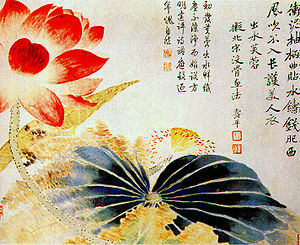- Mogu
-
Mogu (Simplified and Traditional Chinese: 沒骨; Pinyin: Mògǔ), is a painting skill or technique in traditional Chinese painting. It literally means "boneless".[1]
Contents
Derivation of the name
There are mainly two derivatives:
- Mogu-Hua (Tradirtion Chinese: 沒骨畫, or 沒骨畵; Simplified Chinese: 没骨画; Pinyin: Mògǔ Huà; "Huà" means "painting"), mainly mentions the painting or work has such style or created by such technique.[2]
- Mogu-Fa (Tradirtion Chinese: 沒骨法; Simplified Chinese: 没骨法; Pinyin: Mògǔ Fǎ; "Fǎ" means method or technique) emphasizes the technique.[3]
History
 Yun Shouping's Mogu painting: Lotus Flower Breaking the Surface (Traditional Chinese: 出水芙蓉圖; Simplified Chinese: 出水芙蓉图; Pinyin: Chū-shuǐ Fú-Róng Tú) (Palace Museum, Beijing)
Yun Shouping's Mogu painting: Lotus Flower Breaking the Surface (Traditional Chinese: 出水芙蓉圖; Simplified Chinese: 出水芙蓉图; Pinyin: Chū-shuǐ Fú-Róng Tú) (Palace Museum, Beijing)
According to some ancient records, the technique was first created and theorized by Zhang Senyun (Traditional Chinese: 張僧繇; simplified Chinese: 张僧繇; Pinyin: Zhāng Sēng-Yáo) of the Liang Dynasty in 557 during the Southern dynasties period.[1]
During the period of the Five Dynasties and Ten Kingdoms Period, a painter named Huang Quan (黄筌; Huáng Quán) from Former Shu significantly developed the techniques in bird-and-flower painting, especially in painting trees and flowers, and his painting was called as the fine-sounding name Mogu Huazhi (Traditional and Simplified Chinese: 沒骨花枝; Pinyin: Mògǔ Huāzhī).[1]
In Tang Dynasty, notable painters mastered this technique includes Yang Sheng (Traditional Chinese: 楊升; Simplified Chinese: 杨升; Pinyin: Yáng Shēng)
Xu Chongsi (徐崇嗣) during the Northern Song Dynasty continued developing the technique from Huang, and his paintings were named Mogu-Tu (Traditional Chinese: 沒骨圖; Simplified Chinese 没骨图; Pinyin: Mògǔ-Tú). Xu started applying this technique in shan shui painting.[1]
The technique gained popularity during the Late-Ming Dynasty and Qing Dynasty, and the most famous master would be Yun Shouping.
The technique
The method mainly is a staining and dying one, by using ink brush pens. Less or absolutely no sketch or drawing, so people can hardly observe solid lines or curves in the painting.
There are basically three Mogu staining methods: the staining by smearing (渲染; Xuàn-Rǎn), the staining by dotting (点染; Diǎn-Rǎn), and the staining by just filling colours (填染; Tián-Rǎn).
See also
- Yun Shouping: widely regarded as the top Mogu painter.
- Mogu painting is mainly applied in:
- Shan shui painting
- Bird-and-flower painting
References
- ^ a b c d "没骨 (Mogu)" (in Chinese). Baidu Baike. http://baike.baidu.com/view/183922.htm. Retrieved 31 May 2010.
- ^ "没骨画 (Mogu painting)" (in Chinese). Baidu Baike. http://baike.baidu.com/view/500333.html. Retrieved 31 May 2010.
- ^ "没骨法 (Mogu technique)" (in Chinese). Baidu Baike. http://baike.baidu.com/view/756102.htm. Retrieved 31 May 2010.
Categories:
Wikimedia Foundation. 2010.
